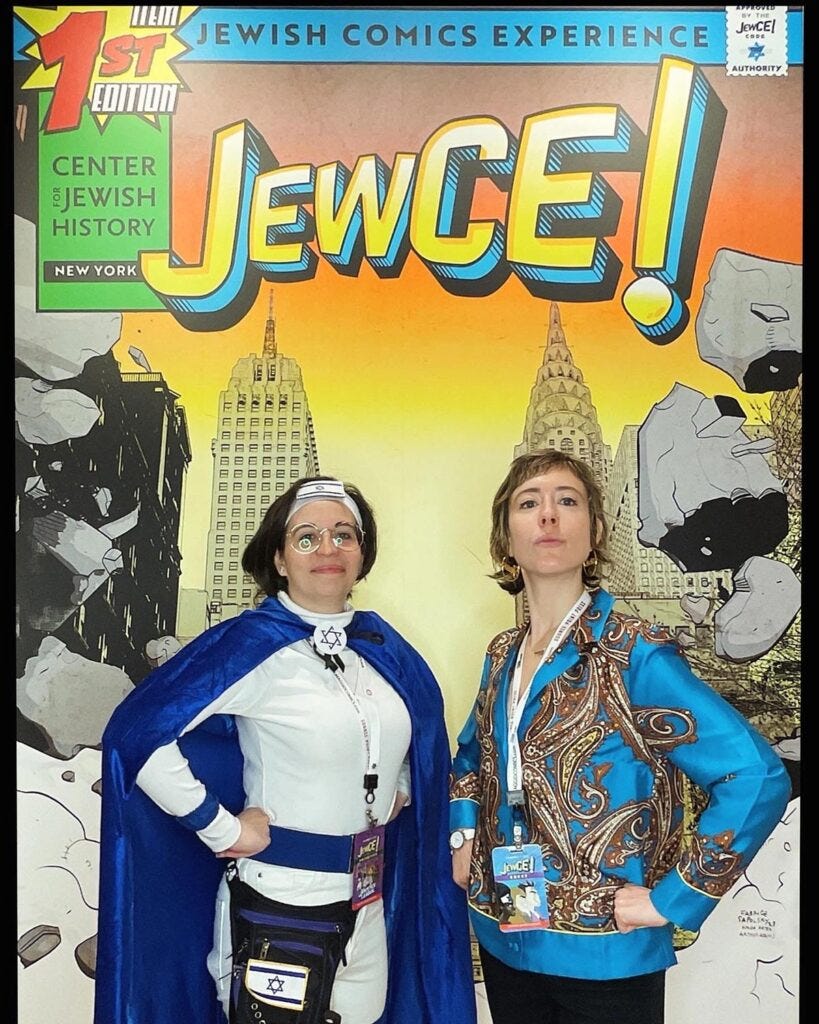🦸The Marvels of Jewish Comics
The comic book industry includes rich Jewish storytelling, both past and present.
Happy Tevet, friends!
The Hebrew month of Tevet is a Babylonian name that connotes “sinking” due to the heavy winter rains this time of year, making the land a muddy swamp. The word shares the Hebrew root with “tov”, meaning good. Try to remember the good during this dark, dreary period, like this cute goat! (And if you can tell me why I included a gif of a goat here in the comments, I’ll give you a genuine, free compliment!)
Now let’s get to the tov stuff… I love uncovering Jewish connections in unexpected places, like those clickbait articles titled, “Fish and Chip’s Surprising Jewish History.”
So when I learned about the Jewish beginnings of the comic book industry and how Jewish the most famous superheroes — Superman, Spider-Man, Captain America — really are, you bet I was tickled.
This interest started last spring, when I came across a comic book seller in Central Park selling a Jewish comic book series called “Israeli Defense Comics.” I was immediately hooked, not only for the spandex suit-clad macho Jewish man fighting terrorists in Gaza (sound familiar?), but how educational and explanatory the issues were. I don’t consider myself an avid comic book reader (I’ve dabbled), but I love the idea of a Jewish superhero with a Jewish background like Marvel’s Sabra, aka Ruth Bat-Seraph, who is both a mutant and a Mossad agent.
What makes a comic Jewish? Is it having a Jewish main character? Centered around Jewish themes like championing justice? A Jewish creator? How about a Jewish illustrator? Is every comic Jewish because the format was pioneered by a Jewish print salesman, Max Gaines? What about all of the above? Would it then be, dare I say, super Jewish?
I wrote a piece for Jewish Unpacked on this sometime ago, diving into the Jewish roots of the comics industry. In this article, you’ll learn why Jews started creating comics for a living, that the most famous comic book artists like Stan Lee were Jewish, and what some scholars say about the Jewish connection of some of your favorite superheroes.
But wait, there’s more! I then attended the first-ever Jewish Comics Experience (JewCE) here in New York, a day-long festival of diverse Jewish voices in today’s industry. Hosted at the Center for Jewish History, hundreds of enthusiastic writers, illustrators, and readers celebrated and uplifted the People of the Book — the comic book, that is.
During a time of war, it was so beautiful to hear Jewish voices share their stories, fictional or not. Jewish voices like queer, Sephardic, hippie, Native American, Hawaiian, Iraqi, and more.

The stories were diverse, too: an 11-year-old Orthodox girl who fights trolls (“Hereville: How Mirka Got Her Sword”), a Jewish Chinese superhero with water powers (“The Last Jewish Daughter of Kaifeng”), a 16th century Jewish pirate (“José and the Pirate Captain Toledano”), to name a few.
But you can read about the experience in depth at Jewish Unpacked, where I wrote another article about the magic of Jewish comics and graphic novels!

📖 Shabbat Plot
If you’re interested in comic book history, I recommend The Amazing Adventures of Kavalier & Clay by Michael Chabon. The story of two teenage cousins, Joe Kavalier and Sammy Clay, and the comics they create in 1930s New York is loosely based on the real creation of Superman. The book depicts the Golden Age of Comic Books and beyond through a tale of fame, friendship, love, and tragedy.
I hope your Shabbat is full of art and storytelling,
P.S. Have you figured out the meaning behind that goat yet? 🐐




I have a deep affection for goats, starting with the Pesah song Had Gadya and then progressing to working with actual goats at my friend's organic regenerative farm in Massachusetts, which is a fancy way of saying a medium-sized farm that grows tasty food. Never in my wildest dreams did I think that a goat gif would light up my Tevet. Thank you!
Because goats are just the best shareable animal ever?